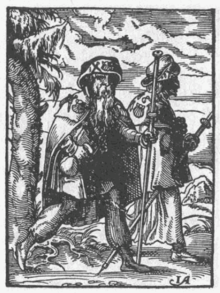Pilgrim shell
The Atlantic scallop , the great pilgrim mussel ( Pecten maximus ), in the form of the right half of the shell of the animal or as a pewter cast of such a shell, became the distinguishing mark of the pilgrims to Santiago de Compostela , since the late 9th century the burial place of St. Jacob and the most important pilgrimage site of the Middle Ages. Carl von Linne confused the Mediterranean pilgrim mussel and the real scallop ( P. maximus or small pilgrim mussel Chlamys opercularis L.) with the name P. jacobaeus to the Mediterranean species that did not live off Santiago .
The large pilgrim shell as a sign of pilgrimage
The real scallop ( P. maximus ) is said to have its name according to a later legend according to the following origin:

A young nobleman once rode to meet the ship with which the body of the apostle James was brought to Spain. Unfortunately, he sank into the sea; however, James miraculously saved his life and helped the knight reach the shore. As a result, his body was covered over and over with shells, and for this reason the shell has been worn as a protective symbol ever since.
Since the early Middle Ages , the right, more arched flaps of the shells have been used as a sign of identification by the pilgrims who visit the grave of St. James in Santiago de Compostela . Originally, the shell was also used as evidence of pilgrimage. The shells were sold at the place of pilgrimage and attached by the pilgrims to clothing, usually to their hats ; the sale of badges was an important source of income for the pilgrimage site. An extension of the pilgrimage route for some pilgrims is the 60 km long way to Cape Finisterre - at “ the end of the world ” - where they themselves collect these mussels in the sea.
Since the 13th century, the pilgrimage was no longer certified with the shell, but with a certificate (today: La Compostela ). Furthermore, a tin cast of a large pilgrim's shell was considered an important, blessing souvenir. Even today, the large pilgrim shell is the pilgrims' identification mark, which is worn visibly on the rucksack.
It also serves to mark the Way of St. James and is often found on road signs, curbs and crossroads. On the branched access routes in France and Germany, it is increasingly becoming a symbol of the pilgrimage route.
Large pilgrim clams have repeatedly been found in European graves, especially from the 11th to 14th centuries, as far as Scandinavia. Old pilgrimage traditions, their chronological order and their local significance can be traced from such grave finds.
heraldry
- See also: List of coats of arms with the scallop shell
- See also: The shell as a heraldic animal
See also
literature
- Brian Spencer: Pilgrim souvenirs and secular badges (= Medieval Finds from Excavations in London. 7). The Stationary Office, London 1998, ISBN 0-11-290574-9 , 244-248.
- Heinz Sulser: The shell of the Jacob pilgrims. In: Quarterly publication of the Natural Research Society in Zurich . Vol. 147, No. 4, 2002, pp. 137-140.
- Kurt Köster : Pilgrim signs and pilgrim shells. In: Sankt Elisabeth: Princess, servant, saint. Articles, documentations, catalog (of the exhibition on the 750th anniversary of the death of St. Elisabeth, Marburg). Sigmaringen 1981, pp. 452-459.
- Kurt Köster: Les coquilles et enseignes de pelerinage de Saint-Jacques de Compostelle et des routes de Saint-Jacques en occident. In: Santiago de Compostela. 1000 ans de pèlerinage Européen. Edited by the Centrum voor Kunst en Cultuur, Gent 1985, pp. 85–95.



